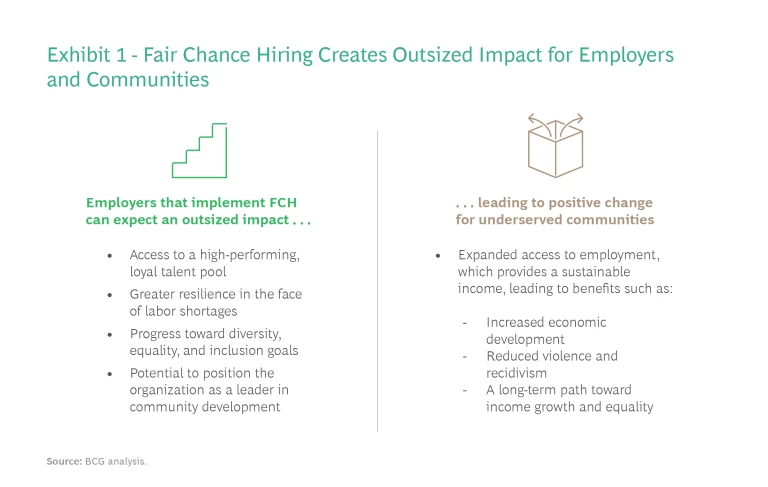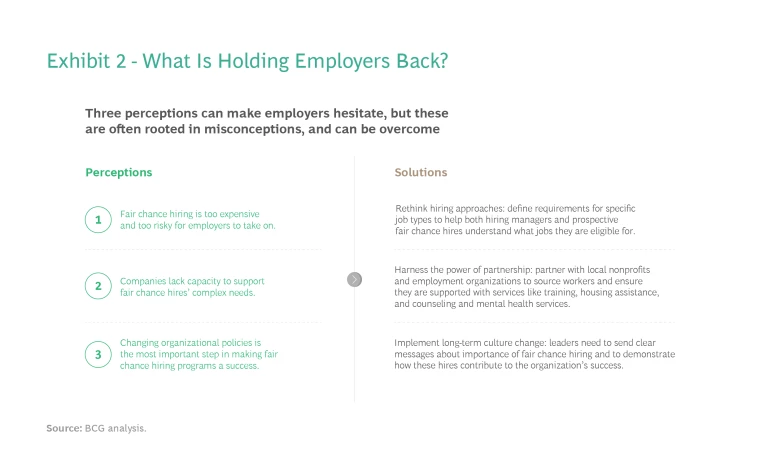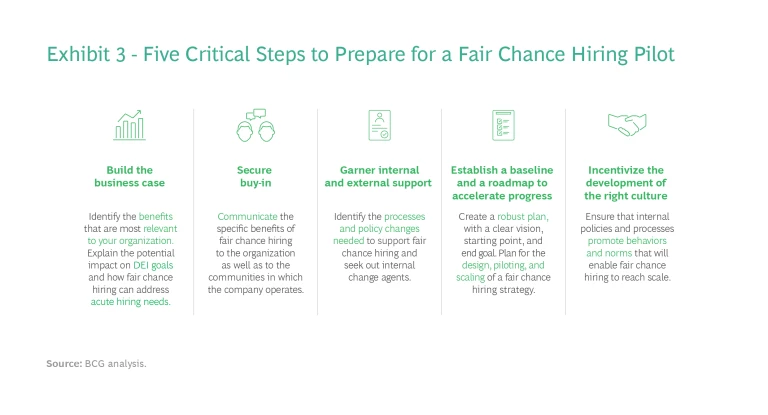Employers face a daunting challenge: job openings outnumber unemployed workers by more than 4.3 million, according to the US Chamber of Commerce. Today’s labor shortage limits companies’ ability to grow and disproportionately affects industries that rely on frontline workers. Yet one source of talent remains significantly underutilized: Americans with a criminal record—nearly one in three of working-age adults. Removing the barriers this population faces in the employment process, also known as fair chance hiring, can help companies address their labor needs.
In partnership with the Corporate Coalition of Chicago, BCG has conducted in-depth research on the US fair chance hiring landscape. We have found that despite the compelling business case for this strategy, it is not widespread.
Fair chance hiring can deliver significant employee productivity and engagement benefits while promising long-term social impact by improving prospects for millions of Americans.
What’s holding employers back? Much of the reluctance comes from perceptions about hiring risks, which are often rooted in misconceptions. These misconceptions mean employers are missing out on an opportunity to hire loyal, motivated employees and build more diverse, inclusive workplaces. Fair chance hiring can deliver significant employee productivity and engagement benefits, as recent data shows, while promising long-term social impact by improving prospects for millions of Americans. (See Exhibit 1.)

A Significant Recruitment Opportunity
As potential recruits, fair chance hires constitute a large labor pool: 70–100 million Americans have a criminal record, according to the Sentencing Project. Whether it is a citation, an arrest, or a conviction, a criminal record can present meaningful barriers to gaining employment. According to a 2018 Prison Policy Initiative report, of the 5 million previously incarcerated individuals in the United States, more than 27% were unemployed—a rate five times higher than in the general population.
For recruiters, there are compelling reasons to embrace fair chance hiring.
Fair chance hires are strong performers. In a 2021 survey by SHRM, the Society for Human Resource Management, the SHRM Foundation, and the Charles Koch Institute, more than 80% of HR professionals and business leaders said fair chance employees performed comparably or better than their counterparts.
Fair chance hires have high retention rates. Research shows that individuals with criminal records have longer job tenure and are less likely to quit their jobs than others. This means fair chance hiring has the potential to generate significant economic impact in the form of improved productivity as well as savings on recruitment and training expenses.
Fair chance hires create more inclusive, diverse workplaces. Black and Latino adults are six and three times more likely, respectively, to be incarcerated than white adults, according to advocacy group FWD.us. Fair chance hiring can have a disproportionately positive impact on these job seekers while enabling employers to build more diverse, inclusive work environments.
Fair chance policies build employee loyalty. In a 2022 survey by online job site Indeed, 96% of workers said they would prefer to work for an organization using fair chance hiring practices, and other research shows that enacting these policies generates loyalty and engagement among all employees.
Stay ahead with BCG insights on people strategy
The Early Movers
In the US, fair chance hiring is gaining momentum. Early-mover employers are demonstrating that these programs can succeed, even in highly regulated industries like aviation and finance. For example, JPMorgan Chase & Co. is investing heavily in fair chance recruitment strategies, with 10% of all its new hires being people with criminal backgrounds that have no bearing on their roles.
Employers committing to fair chance hiring can now tap into active communities of practice nationally and locally. The Second Chance Business Coalition—which includes more than 40 large private-sector companies in the US—provides resources and guidance to support businesses to adopt fair chance policies. The Corporate Coalition of Chicago’s Fair Chance Hiring initiative facilitates knowledge sharing between Chicago-based C-suite leaders as they implement fair chance strategies.
Perceptions and Practical Solutions
Qualified individuals with a criminal record face many obstacles in gaining employment, but among the hardest to surmount are worries about the risks they pose to employers and doubts about their potential as employees. We have identified three key perceptions—often rooted in misconceptions—that discourage employers from adopting fair chance hiring practices. We also provide solutions that can help employers overcome barriers and successfully implement fair chance hiring. (See Exhibit 2.)

Perception 1: Fair chance hiring is too expensive and too risky for employers to take on. Many employers cite the potential legal liability of employing people with criminal records, as well as the cost of additional screening and recruitment reviews. Companies also worry that employees with criminal backgrounds could engage in behaviors that negatively impact reputation and brand perception.
Solution: Rethink hiring approaches. To limit risk, rather than conduct identical applicant assessments for all roles, companies should look at applicants on a more individual basis. When reviewing a candidate with a criminal record, they should consider four factors: the relevance of the charge to the job, the nature of the offense, the age of the record, and evidence of rehabilitation.
A major airline has, for example, developed a matrixed job planning approach that defines specific requirements for each job type and highlights the roles open to individuals, depending on their type of criminal record. This creates transparency and clear guidelines for both HR teams and job seekers.
Similarly, a global credit card company has developed a process that makes it more straightforward for applicants with criminal records to identify roles that they are legally able to hold in the highly regulated financial industry. Through its dedicated adjudication team, the company also offers guidance on how banking regulations affect job opportunities.
Perception 2: Companies lack capacity to support fair chance hires’ complex needs. Applicants who have been incarcerated often face great barriers to professional success as they reintegrate into the workforce. Companies worry that they will not only have to undertake traditional onboarding, training, and professional development for these hires, but will also need to help them reenter society. Some even believe that only a small number of fair chance candidates will ultimately “make it through” the hiring process and so are reluctant to invest capacity in familiarizing them with recruiting processes and professional standards.
Solution: Harness the power of partnership. Employers can collaborate with community-based organizations, tapping into the latter’s deep local expertise and networks, to set up fair chance hires for success.
For example, a major regional healthcare system partners with workforce development organizations—chosen for their regional presence and local impact—that offer support such as job training, counseling and mental health support, and transportation services to overcome public transport route limitations.
Employers can also take advantage of government programs to fund employee supports. The federal Work Opportunity Tax Credit offers companies up to $6,000 in credit for the first year’s employment for hires from target groups, including “qualified ex-felons”—those hired within a year of being convicted of a felony or being released from prison for that felony.
Perception 3: Changing organizational policies is the most important step in making fair chance hiring programs a success. Historically, many companies pursuing fair chance hiring have focused on updating their policies for sourcing and hiring talent. This is necessary but not sufficient and downplays the essential role of organizational culture—changes in mindset and a broader commitment to greater inclusivity and diversity in hiring—in successfully bringing on fair chance employees.
Solution: Invest in long-term culture change. To create a corporate culture that helps fair chance hires integrate into the workforce and position themselves for success, leaders must send clear messages showing their personal commitment to the strategy. Communications efforts should be visible and widespread and should underscore leaders’ belief in the importance of fair chance hiring to the organization and its talent management strategies, as well as to the broader community.
In addition to communicating a compelling case for change, employers should invest in other culture-building measures, such as codifying employee integration practices, developing career paths focused on upward mobility, and analyzing data to improve talent management efforts, fair chance hiring included, and track their progress.
Checkr, a technology company providing employee background checks for organizations, recently integrated the Fair Chance Dashboard—which enables customers to assess their progress on fair chance hiring guidelines and learn about others’ success stories—into its offering. The dashboard promotes a more modern approach to candidate review across a broad range of verticals, from customer experience to engineering, and from entry-level roles up through executives.
Making It Happen
Fair chance hiring requires time and investment. However, using a step-by-step approach, committed leaders can quickly launch, implement, and reap the benefits of fair chance hiring. Companies can start small by implementing pilot programs in a targeted geography or for a specific set of roles or job functions before rolling out the strategy across the organization. Each step outlined below delivers positive impact and creates wins for the business.
Step 1: Build the business case. Identify the benefits that are most relevant to your organization. Questions to ask include what economic benefits fair chance hiring will bring the company, what impact it could have on diversity, equity, and inclusion goals, and what acute talent needs it could address.
Step 2: Secure buy-in. Set out the specific benefits of fair chance hiring to the organization, as well as to the communities in which the company operates. The most effective communications strategies range from public commitments to internal messaging and consider local context, industry sector, and the nature of the employer’s business.
Step 3: Garner internal and external support. Identify the processes and policy changes needed to support fair chance hiring and seek out internal change agents—human resources teams, board members, high-profile hiring managers—and external partners that can champion and help execute the strategy.
Step 4: Establish a baseline and a roadmap to accelerate progress. Create a robust plan, with a clear vision and end goal, and then plan for the design, piloting, and scaling of a fair chance hiring strategy. Establishing a baseline that makes it possible to track progress and measure impact is critical—especially with continuous improvement in mind.
Step 5: Incentivize the development of the right culture. Ensure that internal policies and processes promote behaviors and norms that will enable fair chance hiring to be accepted and to reach scale. This includes recognizing an inclusive culture in employee evaluations and incentives, developing accountability mechanisms, and embedding fair chance approaches in strategies such as training and change management. (See Exhibit 3.)

Fair Chance’s First-Mover Advantage
Fair chance hiring is still far from reaching its potential, but interest is growing. Encouragingly, some concerns about fair chance hiring are becoming less prevalent. For example, in a 2021 survey conducted by SHRM, the SHRM Foundation, and the Charles Koch Institute on hiring and working with people with criminal records, only 34% of respondents cited legal liability as a significant concern—down from 42% in 2018.
Meanwhile, new legislation will support expansion of educational opportunities for incarcerated Americans through the US Department of Education’s restoration of Pell Grant eligibility—federally funded financial aid for college students. This could result in many more individuals acquiring not just skills but also the degrees and credentials needed to make them more competitive in the labor market.
Fair chance hiring offers a compelling talent solution that enables employers to attract candidates who, with the right supports, are likely to become engaged, effective, loyal employees and contribute to workplace diversity.
As misconceptions fade and confidence grows in the business case around fair chance hiring, innovative employers equipped with the right advice, policy tools, and organizational culture have an opportunity to lead on this critical approach to talent and to create tangible impact for their people, their organizations, and their communities.











